course
An Introduction to Convolutional Neural Networks (CNNs)
What is a Convolutional Neural Network (CNN)?
A Convolutional Neural Network (CNN), also known as ConvNet, is a specialized type of deep learning algorithm mainly designed for tasks that necessitate object recognition, including image classification, detection, and segmentation. CNNs are employed in a variety of practical scenarios, such as autonomous vehicles, security camera systems, and others.
The importance of CNNs
There are several reasons why CNNs are important in the modern world, as highlighted below:
- CNNs are distinguished from classic machine learning algorithms such as SVMs and decision trees by their ability to autonomously extract features at a large scale, bypassing the need for manual feature engineering and thereby enhancing efficiency.
- The convolutional layers grant CNNs their translation-invariant characteristics, empowering them to identify and extract patterns and features from data irrespective of variations in position, orientation, scale, or translation.
- A variety of pre-trained CNN architectures, including VGG-16, ResNet50, Inceptionv3, and EfficientNet, have demonstrated top-tier performance. These models can be adapted to new tasks with relatively little data through a process known as fine-tuning.
- Beyond image classification tasks, CNNs are versatile and can be applied to a range of other domains, such as natural language processing, time series analysis, and speech recognition.
Inspiration Behind CNN and Parallels With The Human Visual System
Convolutional neural networks were inspired by the layered architecture of the human visual cortex, and below are some key similarities and differences:
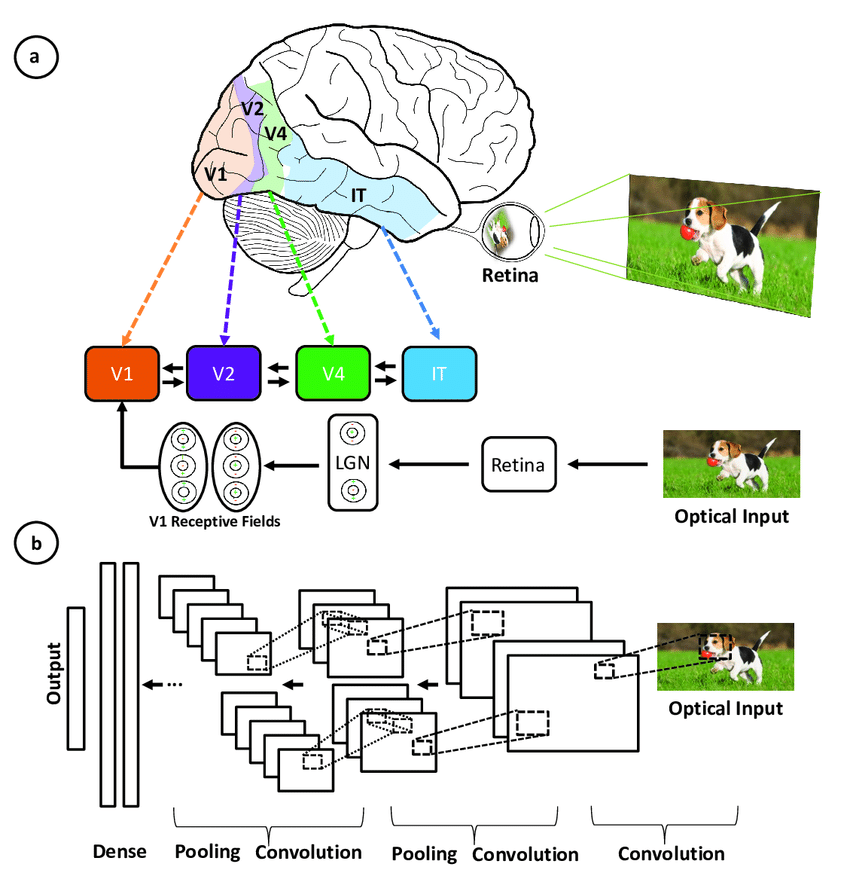
Illustration of the correspondence between the areas associated with the primary visual cortex and the layers in a convolutional neural network (source)
- Hierarchical architecture: Both CNNs and the visual cortex have a hierarchical structure, with simple features extracted in early layers and more complex features built up in deeper layers. This allows increasingly sophisticated representations of visual inputs.
- Local connectivity: Neurons in the visual cortex only connect to a local region of the input, not the entire visual field. Similarly, the neurons in a CNN layer are only connected to a local region of the input volume through the convolution operation. This local connectivity enables efficiency.
- Translation invariance: Visual cortex neurons can detect features regardless of their location in the visual field. Pooling layers in a CNN provide a degree of translation invariance by summarizing local features.
- Multiple feature maps: At each stage of visual processing, there are many different feature maps extracted. CNNs mimic this through multiple filter maps in each convolution layer.
- Non-linearity: Neurons in the visual cortex exhibit non-linear response properties. CNNs achieve non-linearity through activation functions like ReLU applied after each convolution.
CNNs mimic the human visual system but are simpler, lacking its complex feedback mechanisms and relying on supervised learning rather than unsupervised, driving advances in computer vision despite these differences.
Key Components of a CNN
The convolutional neural network is made of four main parts.
But how do CNNs Learn with those parts?
They help the CNNs mimic how the human brain operates to recognize patterns and features in images:
- Convolutional layers
- Rectified Linear Unit (ReLU for short)
- Pooling layers
- Fully connected layers
This section dives into the definition of each one of these components through the example of the following example of classification of a handwritten digit.
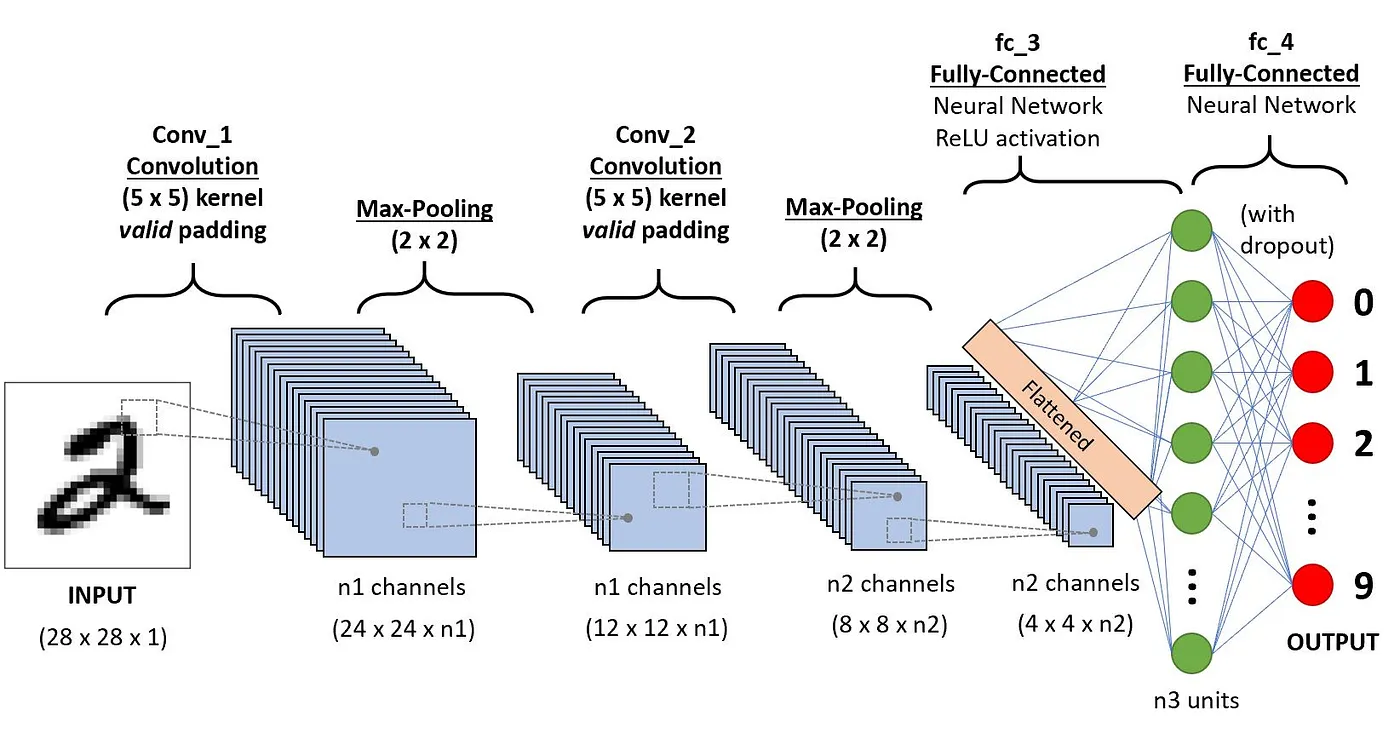
Architecture of the CNNs applied to digit recognition (source)
Convolution layers
This is the first building block of a CNN. As the name suggests, the main mathematical task performed is called convolution, which is the application of a sliding window function to a matrix of pixels representing an image. The sliding function applied to the matrix is called kernel or filter, and both can be used interchangeably.
In the convolution layer, several filters of equal size are applied, and each filter is used to recognize a specific pattern from the image, such as the curving of the digits, the edges, the whole shape of the digits, and more.
Put simply, in the convolution layer, we use small grids (called filters or kernels) that move over the image. Each small grid is like a mini magnifying glass that looks for specific patterns in the photo, like lines, curves, or shapes. As it moves across the photo, it creates a new grid that highlights where it found these patterns.
For example, one filter might be good at finding straight lines, another might find curves, and so on. By using several different filters, the CNN can get a good idea of all the different patterns that make up the image.
Let’s consider this 32x32 grayscale image of a handwritten digit. The values in the matrix are given for illustration purposes.
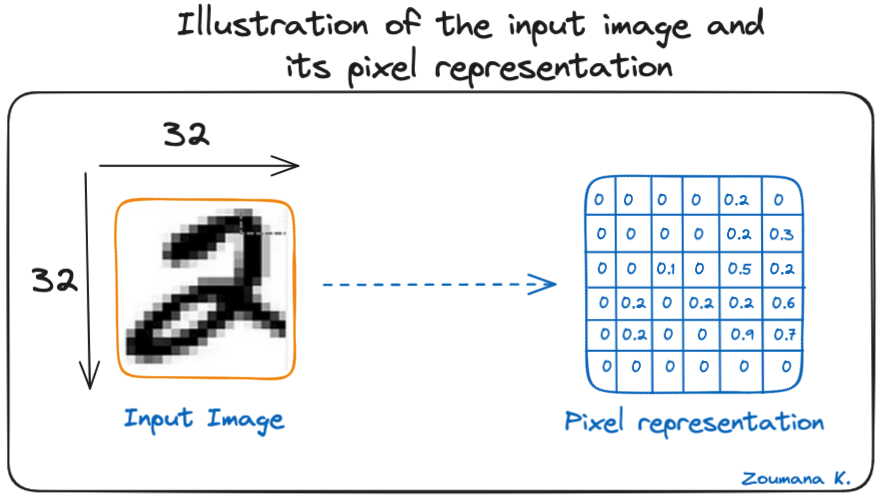
Illustration of the input image and its pixel representation
Also, let’s consider the kernel used for the convolution. It is a matrix with a dimension of 3x3. The weights of each element of the kernel is represented in the grid. Zero weights are represented in the black grids and ones in the white grid.
Do we have to manually find these weights?
In real life, the weights of the kernels are determined during the training process of the neural network.
Using these two matrices, we can perform the convolution operation by applying the dot product, and work as follows:
- Apply the kernel matrix from the top-left corner to the right.
- Perform element-wise multiplication.
- Sum the values of the products.
- The resulting value corresponds to the first value (top-left corner) in the convoluted matrix.
- Move the kernel down with respect to the size of the sliding window.
- Repeat steps 1 to 5 until the image matrix is fully covered.
The dimension of the convoluted matrix depends on the size of the sliding window. The higher the sliding window, the smaller the dimension.

Application of the convolution task using a stride of 1 with 3x3 kernel
Another name associated with the kernel in the literature is feature detector because the weights can be fine-tuned to detect specific features in the input image.
For instance:
- Averaging neighboring pixels kernel can be used to blur the input image.
- Subtracting neighboring kernel is used to perform edge detection.
The more convolution layers the network has, the better the layer is at detecting more abstract features.
Activation function
A ReLU activation function is applied after each convolution operation. This function helps the network learn non-linear relationships between the features in the image, hence making the network more robust for identifying different patterns. It also helps to mitigate the vanishing gradient problems.
Pooling layer
The goal of the pooling layer is to pull the most significant features from the convoluted matrix. This is done by applying some aggregation operations, which reduce the dimension of the feature map (convoluted matrix), hence reducing the memory used while training the network. Pooling is also relevant for mitigating overfitting.
The most common aggregation functions that can be applied are:
- Max pooling, which is the maximum value of the feature map
- Sum pooling corresponds to the sum of all the values of the feature map
- Average pooling is the average of all the values.
Below is an illustration of each of the previous example:
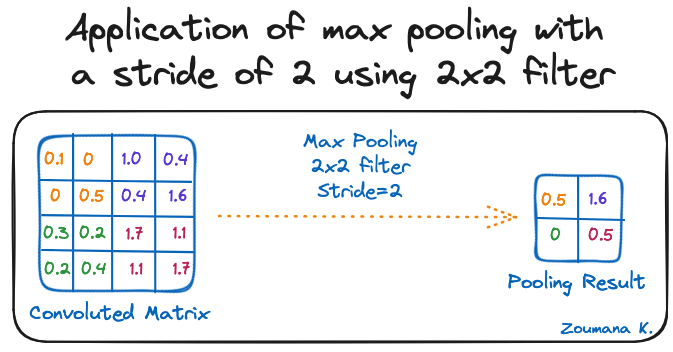
Application of max pooling with a stride of 2 using 2x2 filter
Also, the dimension of the feature map becomes smaller as the pooling function is applied.
The last pooling layer flattens its feature map so that it can be processed by the fully connected layer.
Fully connected layers
These layers are in the last layer of the convolutional neural network, and their inputs correspond to the flattened one-dimensional matrix generated by the last pooling layer. ReLU activations functions are applied to them for non-linearity.
Finally, a softmax prediction layer is used to generate probability values for each of the possible output labels, and the final label predicted is the one with the highest probability score.
Overfitting and Regularization in CNNs
Overfitting is a common challenge in machine learning models and CNN deep learning projects. It happens when the model learns the training data too well (“learning by heart”), including its noise and outliers. Such a learning leads to a model that performs well on the training data but badly on new, unseen data.
This can be observed when the performance on training data is too low compared to the performance on validation or testing data, and a graphical illustration is given below:
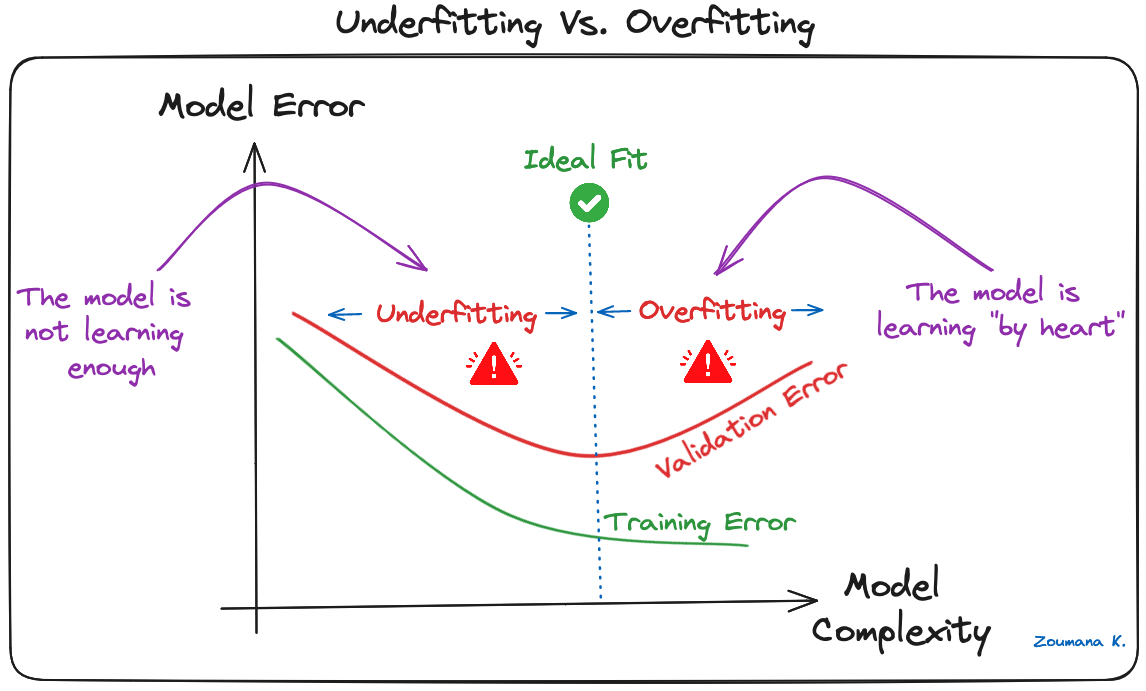
Underfitting Vs. Overfitting
Deep learning models, especially Convolutional Neural Networks (CNNs), are particularly susceptible to overfitting due to their capacity for high complexity and their ability to learn detailed patterns in large-scale data.
Several regularization techniques can be applied to mitigate overfitting in CNNs, and some are illustrated below:
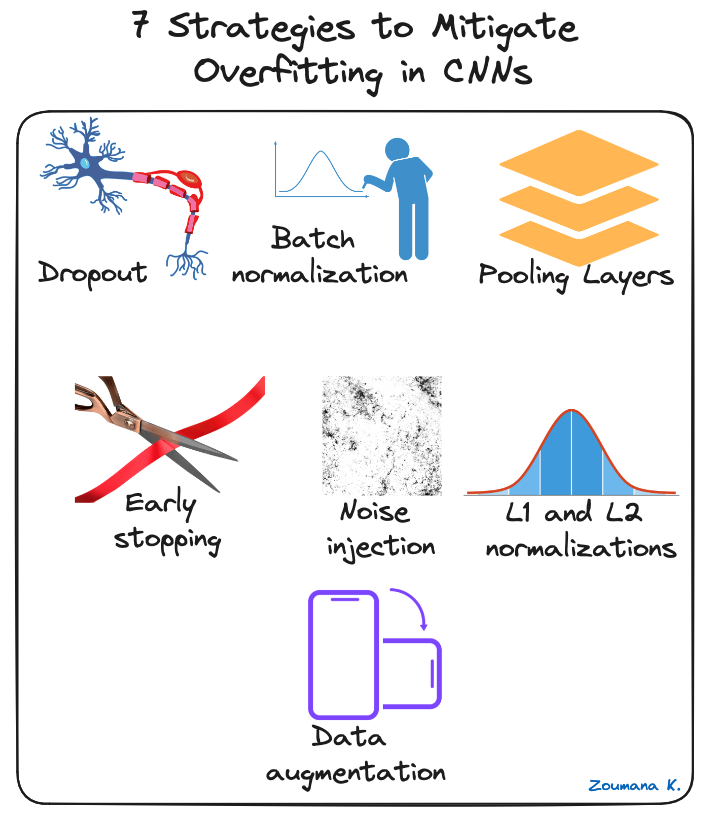
7 strategies to mitigate overfitting in CNNs
- Dropout: This consists of randomly dropping some neurons during the training process, which forces the remaining neurons to learn new features from the input data.
- Batch normalization: The overfitting is reduced at some extent by normalizing the input layer by adjusting and scaling the activations. This approach is also used to speed up and stabilize the training process.
- Pooling Layers: This can be used to reduce the spatial dimensions of the input image to provide the model with an abstracted form of representation, hence reducing the chance of overfitting.
- Early stopping: This consists of consistently monitoring the model’s performance on validation data during the training process and stopping the training whenever the validation error does not improve anymore.
- Noise injection: This process consists of adding noise to the inputs or the outputs of hidden layers during the training to make the model more robust and prevent it from a weak generalization.
- L1 and L2 normalizations: Both L1 and L2 are used to add a penalty to the loss function based on the size of weights. More specifically, L1 encourages the weights to be spare, leading to better feature selection. On the other hand, L2 (also called weight decay) encourages the weights to be small, preventing them from having too much influence on the predictions.
- Data augmentation: This is the process of artificially increasing the size and diversity of the training dataset by applying random transformations like rotation, scaling, flipping, or cropping to the input images.
Practical Applications of CNNs
Convolutional Neural Networks have revolutionized the field of computer vision, leading to significant advancements in many real-world applications. Below are a few examples of how they are applied.

Some practical applications of CNNs
- Image classification: Convolutional neural networks are used for image categorization, where images are assigned to predefined categories. One use of such a scenario is automatic photo organization in social media platforms.
- Object detection: CNNs are able to identify and locate multiple objects within an image. This capability is crucial in multiple scenarios of shelf scanning in retail to identify out-of-stock items.
- Facial recognition: this is also one of the main industries of application of CNNs. For instance, this technology can be embedded into security systems for efficient control of access based on facial features.
For a more hands-on implementation, our Convolutional Neural Networks (CNN) with TensorFlow Tutorial teaches how to construct and implement CNNs in Python with Tensorflow Framework 2.
Deep Learning Frameworks for CNNs
The rapid growth of deep learning is mainly due to powerful frameworks like Tensorflow, Pytorch, and Keras, which make it easier to train convolutional neural networks and other deep learning models.
Let’s have a brief overview of each framework.
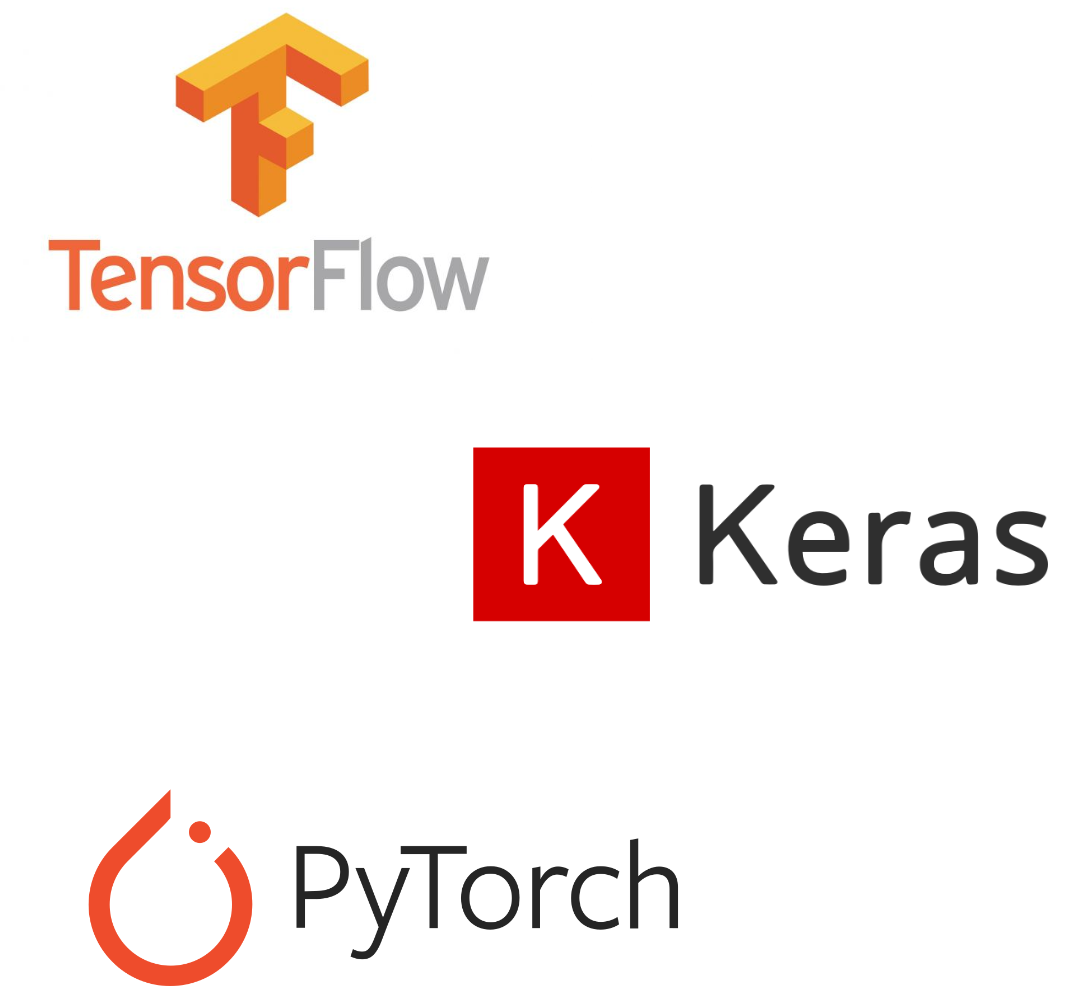
Tensorflow, Keras and Pytorch logos
Tensorflow
TensorFlow is an open-source deep learning framework developed by Google and released in 2015. It offers a range of tools for machine learning development and deployment. Our Introduction to Deep Neural Networks provides a complete guide to understanding deep neural networks and their significance in the modern deep learning world of artificial intelligence, along with real-world implementations in Tensorflow.
Keras
Keras is a high-level neural network framework in Python that enables rapid experimentation and development. It's open-source and can be used within other frameworks like TensorFlow, CNTK, and Theano. Our course, Image Processing with Keras in Python, teaches how to conduct image analysis using Keras with Python by constructing, training, and evaluating convolutional neural networks.
Pytorch
Released by Facebook's AI research division in 2017, it's designed for applications in natural language processing and is noted for its dynamic computational graph and memory efficiency. If you are interested in diving into Natural Language Processing, Our NLP with PyTorch: A Comprehensive Guide is a great starting point.
Each project is different, so the decision really depends on what characteristics are most important for a given use case. To help make better decisions, the following table provides a brief comparison of these frameworks, highlighting their unique features.
|
Tensorflow |
Pytorch |
Keras |
|
|
API Level |
Both (High and Low) |
Low |
High |
|
Architecture |
Not easy to use |
Complex, less readable |
Simple, concise, readable |
|
Datasets |
Large datasets, high performance |
Large datasets, high performance |
Smaller datasets |
|
Debugging |
Difficult to conduct debugging |
Good debugging capabilities |
Simple network, so debugging is not often needed |
|
Pretrained models? |
Yes |
Yes |
Yes |
|
Popularity |
Second most popular of the three |
Third most popular of the three |
Most popular of the three |
|
Speed |
Fast, high-performance |
Fast, high-performance |
Slow, low performance |
|
Written in |
C++, CUDA, Python |
Lua |
Python |
Comparative table between Tensorflow, Pytorch and Keras (source)
Conclusion
This article has provided a complete overview of what a CNN in deep learning is, along with their crucial role in image recognition and classification tasks.
It started by highlighting the inspiration drawn from the human visual system for the design of CNNs and then explored the key components that allow these networks to learn and make predictions.
The issue of overfitting was acknowledged as a significant challenge to CNNs' generalization capability. To mitigate this, a variety of relevant strategies to mitigate overfitting and improve CNNs overall performance were outlined.
Finally, some major deep learning CNN frameworks have been mentioned, along with the unique features of each one and how they compare to each other.
Eager to dive further into the world of AI, and machine learning? Take your expertise to the next level by enrolling in the Deep Learning with PyTorch course today.

A multi-talented data scientist who enjoys sharing his knowledge and giving back to others, Zoumana is a YouTube content creator and a top tech writer on Medium. He finds joy in speaking, coding, and teaching . Zoumana holds two master’s degrees. The first one in computer science with a focus in Machine Learning from Paris, France, and the second one in Data Science from Texas Tech University in the US. His career path started as a Software Developer at Groupe OPEN in France, before moving on to IBM as a Machine Learning Consultant, where he developed end-to-end AI solutions for insurance companies. Zoumana joined Axionable, the first Sustainable AI startup based in Paris and Montreal. There, he served as a Data Scientist and implemented AI products, mostly NLP use cases, for clients from France, Montreal, Singapore, and Switzerland. Additionally, 5% of his time was dedicated to Research and Development. As of now, he is working as a Senior Data Scientist at IFC-the world Bank Group.
Start Your Deep Learning Journey Today!
course
Introduction to Deep Learning with PyTorch
course
Introduction to Deep Learning with Keras
tutorial
Convolutional Neural Networks (CNN) with TensorFlow Tutorial
tutorial
Convolutional Neural Networks in Python with Keras
tutorial
Introduction to Deep Neural Networks
tutorial
Multilayer Perceptrons in Machine Learning: A Comprehensive Guide
tutorial
Mastering Backpropagation: A Comprehensive Guide for Neural Networks
tutorial